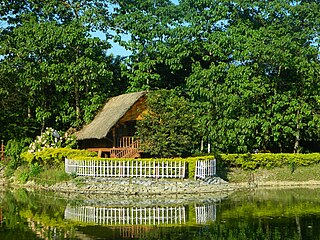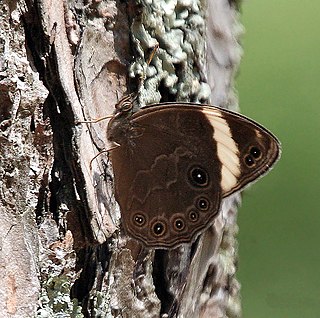In Greek mythology, Lethe, also referred to as Lesmosyne, was one of the rivers of the underworld of Hades. Also known as the Amelēs potamos, the Lethe flowed around the cave of Hypnos and through the Underworld where all those who drank from it experienced complete forgetfulness. Lethe was also the name of the Greek spirit of forgetfulness and oblivion, with whom the river was often identified.

Goalpara district is an administrative district of the Indian state of Assam.

Goalpara ) is the district headquarters of Goalpara district, Assam, India. It is situated 134 kilometres (83 mi) to the west of Guwahati.

Lethe is a butterfly genus from the subfamily Satyrinae in the family Nymphalidae. The genus was erected by Jacob Hübner in 1819. It includes the treebrowns, woodbrowns, foresters and their relatives. The species in the genus Lethe occur in temperate-tropical southern and eastern Asia, up to Indonesia and in North America.

Goalpariya is a group of Indo-Aryan dialects spoken in the Goalpara region of Assam, India. Along with Kamrupi, they form the western group of Assamese dialects. The North Bengali dialect is situated to its west, amidst a number of Tibeto-Burman speech communities. The basic characteristic of the Goalpariya is that it is a composite one into which words of different concerns and regions have been amalgamated. Deshi people speak this language and there are around 20 lakhs people.

The state of Assam in India has five regional divisions, each comprising a number of districts. The person responsible for the administration of a division is designated as a Divisional Commissioner.

Lethe Vallis is a valley in the Elysium Planitia on Mars, located at 4° North and 206.5° West. It is 225 km long and is named after river Lethe in Katmai National Monument, Alaska, USA. Lethe Vallis originates at the SE margin of the West Elysium Basin. West Elysium Basin probably contained a lake that was 500 km across and received water from Athabasca Vallis. It was probably formed in just days or weeks and had a discharge about like the Mississippi. Some have suggested it was formed from lava flows, but lava would not be able to flow over such a low gradient for so long a distance.

Lethe chandica, the angled red forester, is a species of Satyrinae butterfly found in the Indomalayan realm.

Lethe kansa, the bamboo forester, is a species of Satyrinae butterfly found in the Indomalayan realm

Lethe sinorix, the tailed red forester, is a species of Satyrinae butterfly found in the Indomalayan realm

Lethe latiaris , the pale forester, is a species of Satyrinae butterfly found in the Indomalayan realm

Lethe gulnihal , the dull forester, is a species of Satyrinae butterfly found in the Indomalayan realm

Lethe verma , the straight-banded treebrown, is a species of Satyrinae butterfly found in the Indomalayan realm

Lethe siderea , the scarce woodbrown, is a species of Satyrinae butterfly found in the Indomalayan realm. The species was first described by George Frederick Leycester Marshall in 1880. It is legally protected in India under Schedule II of the Wild Life (Protection) Act, 1972.

Lethe maitrya, the barred woodbrown, is a species of Satyrinae butterfly found in the Indomalayan realm.

Lethe ramadeva, the single silverstripe, is a species of Satyrinae butterfly found in the Indomalayan realm.

Lethe dura, the scarce lilacfork, is a species of Satyrinae butterfly found in the Indomalayan realm.
















